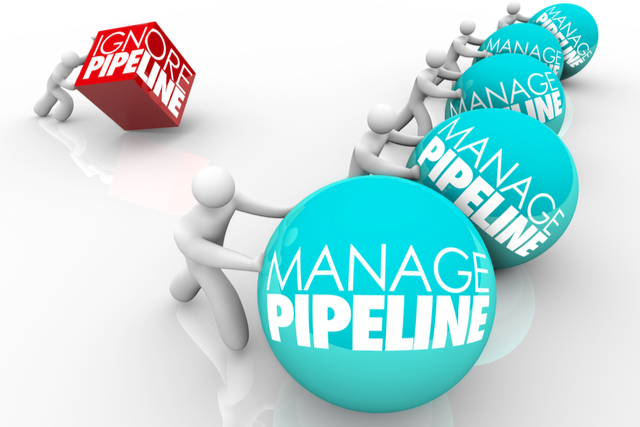Every successful salesperson knows they have to keep their pipeline full if they want to convert prospects to customers. It takes a constant stream of prospects into the pipeline to create a steady stream of conversions.
What is Sales Pipeline Management?
Sales pipeline management lets you track each of the prospects as they enter and move through the various stages of the buying journey.
Why Is Sales Pipeline Management Important?
A sales pipeline lets you track the process more efficiently, but it also helps you plan and evaluate activities at each stage. Sales pipeline management can provide insight into the sales process to analyze what’s working and what needs attention.
Nearly every part of the sales pipeline can be tracked, monitored, and measured.
As a sales or marketing manager, this can give you insight into how well your marketing materials are working (or not working) and where prospects are not converting. It can also help you evaluate performance by members of your sales team. For example, it can help you identify where certain salespeople aren’t progressing sales as well as the rest of the team. If you notice certain team members seem to get stuck at a certain stage, you can provide additional coaching or sales training.
By tracking each interaction at each stage, you can also evaluate the impact of your marketing. If your inbound marketing efforts are failing to generate sales qualified leads, for example, it may indicate you need to change strategies. If your salespeople aren’t converting sales qualified leads at the rate you need, they may need additional support.
An effective sales pipeline should help you:
- Identify and target weak points in each stage of your pipeline
- Pinpoint areas where additional coaching or sales training can help
- Understand and analyse why some deals didn’t close
- Prepare for potential sales growth or downturns

How Do You Create a Sales Pipeline?
Building your sales pipeline begins by identifying the various stages that buyers pass through en route to conversions. Buyers take different paths in different industries or for different products so this step will take some time to map how your customers do it. To effectively manage your pipeline, you’ll need to mirror the buying process as closely as possible to align your sales processes.
1. Focus on the Customer
A lot of people stumble with this first step because they fail to think about the buying process from the customer’s point of view. Here’s an example. Let’s say a potential customer goes to your website and gives you an email in exchange for downloading a Whitepaper. The information gets routed to a salesperson who contacts the prospect to qualify them. This triggers the generation of a proposal.
How many stages have the customer moved through the B2B sales pipeline? If you said three (first contact to qualified lead to proposal), you’re thinking like a salesperson. In essence, the buyer may be no farther along in the buying process than the first contact. The stages in an effective sales pipeline will align with the buyer’s journey, not the sales process. The sales process should engage buyers at their stage.
B2B sales are more complex and take longer than in the B2C world. The longer your customer’s journey, the more stages there will be. Break down stages when B2B buyers move to the next stage by indicating an increased commitment to the sales process.
You may have heard this process referred to as customer journey mapping.
2. Conduct Customer Journey Mapping
While every customer journey will be different depending on your product and industry, here is an example of how you might manage your sales pipeline by splitting it into stages to get started.
Sample Sales Pipelines
- Prospect new leads
- Qualify leads
- Connect with leads
- Initial appointment, meeting, or conversation
- Identify needs and pain points
- Present solutions
- Overcome objections
- Close the deal
- Generate referrals
- Maintain the relationship
One of the advantages of sales pipeline management is that you can identify at a glance the number of deals that are at each stage with your sales team to make sure your team takes the right action to move prospects from one stage to the next. While many business sales leaders and sales teams may do the things that generate sales revenue instinctively, the pipeline management process helps keep track of things in a documented and formal way. It helps stop reps”forgetting” to act at a certain stage – especially if you know that the right action can lead your team to higher conversion rates.
3. Identify What Happens at Each Stage
You’ll want to analyse each stage to determine what the best practices are for advancing prospects to the next one in the sales cycle. Managing your pipeline will help ensure the right steps are being taken by your sales reps.

You will also need to examine each of the sales pipeline stages for differences in the conversion rate at prospect advance at every stage. This can help determine what leads to sales velocity. This can you pinpoint yield probability or conversion rate depending on activity.
Pipeline metrics can also help you analyse the sales funnel to see how long prospects stay in each stage of the pipeline. If you know, for example, that the majority of sales close after getting a customised demo within two weeks, it can help you identify patterns. If two weeks pass without a close, it may indicate that the likelihood of converting that prospect is lower.
This can help improve your future sales forecast and make sure you have the right number of prospects in each stage of the pipeline to hit your quota. After establishing a baseline, it can also help evaluate where deals get stuck. This may indicate you need additional sales and marketing tools, a change in strategy, or additional coaching or sales training to help your sales reps.
4. Establish Sales Pipeline Metrics
When setting up your sales pipeline, you’ll need to carefully choose the metrics you want to track. Much of it depends on the granularity you need. Here are some of the common measurements used by managers to track the sales process through each phase of the pipeline.
Sample Sales Pipeline Metrics
- Number of deals: How many qualified leads are in each phase of the pipeline at any time, where they are, and what is the best activity to move them to the next phase. This helps sales managers monitor the health of the sales process.
- Deal value: What’s the total amount of potential revenue in your pipeline at any given time. This can help you do a better job of sales forecasting.
- Conversion ratio: Knowing the average conversion ratio at each phase helps you forecast how many of the prospects are likely to move forward in the process. It can also identify where prospects get stuck.
- Close rates: Lots of prospects, conversions, and sales activity is great but the what matters is you need to close deals. Tracking your close rates for the sales team as a whole and individual sales team members can help you with forecasting and identify areas where sales training or coaching can help.
- Sales Velocity: Sales velocity is an important measuring stick. It helps you understand how long it takes to move a qualified lead through the customer journey before they become a paying customer.
5. Managing Sales Activities
Once you’ve established your baseline, you can work backward to analyse how many prospects you need at each stage of the sales funnel to hit your goals.
Here’s an example of how you might determine your goals. Let’s say for every 5 presentations you make, you typically close 1 sale. You also know that it takes meeting with 10 prospects to identify their needs to generate 5 presentations. You can work your way up the line for each and identify the actions it takes to determine the sales activity you need.
Sample Sales Activity Pipeline
- 5 Presentations = 1 Close
- 10 Meetings = 5 Presentations
- 20 Appointments = 10 Meetings
- 50 calls = 20 Appointments
- 100 Qualified Leads = 50 calls
- 200 Prospects = 100 Qualified Leads

In this example, you would need to generate 200 prospective leads for every closed deal you win. While your ratios will vary from the example, you can see how this works. This can help you see a visual representation of how much sales activity has to take place at each stage of the funnel to close deals.
You can use this approach against your sales cycle and then break it down to individual sales reps. In this example, if you need to close 5 deals a month, you now know it will take driving 1,000 prospects (5 x 200) into your sales funnel to get started each month. If you’ve got a sales team of 10 reps, that means each will need to input 100 prospects into your CRM software or pipeline management system each month. That might means every sales rep needs to come up with five new prospects every day in your pipeline, for example.
Sales managers can determine whether there’s enough in the pipeline in each stage to get the results they need and measure a sales rep against their pipeline performance. This leads to better decision making as you work to improve your sales.
As you evaluate the sales pipeline in your company by working backward from the bottom line, you can better forecast potential revenue, the steps and actions it takes, and where you’re missing the mark. When you’re balancing many deals, having the right sales data at the right time can be the best way to manage your pipeline.
It also helps these managers see how they can best help their sales teams. For example, you might have team members that are great at prospecting but not as good about getting that in-depth meeting to uncover the pain points you need to customise a solution. As a sales manager, you can make sure to provide coaching or sales training at the right pipeline phase to help them do a better job for your company.
Keep in mind that each sales rep’s performance will also vary. Someone that’s great at closing may need fewer presentations and appointments. That’s why it’s important to create a baseline and work backward from team goals and individual sales goals.
6. Evaluate Your Sales Process
When you know the amount of activity that’s required, you can now evaluate the quality of the activity being done to help develop and refine your sales process.
By determining what actions move prospects to the next phase of the funnel, you can use this information to create more effective sales collateral and techniques. Do phone calls, video calls, or emails work best to get the appointment in your company? When you know the answer, you can often streamline the process. This can make your sales team more efficient and give them better direction on the best practices to maximise closes.
Keeping Your Sales Pipeline Clean
Your sales pipeline will only be as effective as the data that’s been input and kept up to date. Make sure you set clear expectations about keeping data current and accurate.
For example, let’s say you’ve been progressing a prospect through the pipeline and they leave the company for another job. If you don’t update the information in your CRM software and your pipeline, you’ll have problems. You might be expecting a deal to progress when actually you’re going to have to start at the beginning with a new buyer.
You should also conduct formal pipeline reviews. When prospects are stuck for too long in one stage or aren’t responding to the efforts that normally allow them to advance, it’s time to re-evaluate your efforts. Are they still a viable prospect? Do you need to create a new strategy to move them along? Do you need to do more sales training or coaching for your sales rep?
When you find prospects that you simply can’t advance in the sales pipeline, it’s time for some house cleaning. It can be tempting to keep them in the system just in case but that rarely happens. More likely, if you do re-engage with them in the future, you will need to start the process over at the beginning. If they remain in your system at the wrong stage, you might take the wrong action.
Sales pipeline cleaning should be part of your review process.
How Do You Conduct a Pipeline Review?
It’s helpful to have regularly scheduled pipeline review meetings with your sales reps to keep them on track and uncover any stumbling blocks in the process.
As a sales manager, you can review the data and pipeline metrics before the meeting or when you get together with your sales team members. Let your sales rep walk you through the data and summarise each deal, their activity, and what they are planning as their next step. This gives you an opportunity to review their strategy, determine whether they are on track, and make recommendations.
At the end of your pipeline review, you should feel confident that there is an action plan for each deal that’s in the pipeline. Enter this information into the CRM to capture what you’ve discussed to help ensure the action steps get followed.
A pipeline review is a great way to uncover when prospects aren’t progressing as they should and develop new strategies to unclog the pipe. It often leads to greater insights that can help the entire sales team and total company sales efforts. While sales reps may initially see these pipeline reviews in a negative light, over time the best sales reps will embrace the process for two reasons:
- It leads to results
- It forces a conversation about better ways to sell
The best sales managers use pipeline reviews to help identify strengths and weaknesses, provide coaching and sales training opportunities, and help sales reps meet their goals.





